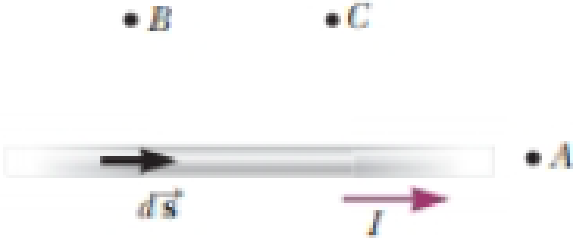
Physics For Scientists And Engineers With Modern Physics, 9th Edition, The Ohio State University
9th Edition
ISBN: 9781305372337
Author: Raymond A. Serway | John W. Jewett
Publisher: Cengage Learning
expand_more
expand_more
format_list_bulleted
Concept explainers
Textbook Question
Chapter 30.1, Problem 30.1QQ
Consider the magnetic field due to the current in the wire shown in Figure 29.2. Rank the points A, B, and C in terms of magnitude of the magnetic field that is due to the current in just the length element
Figure 29.2 (Quick Quiz 29.1) Where is the magnetic field due to the current element the greatest?

Expert Solution & Answer
Trending nowThis is a popular solution!

Students have asked these similar questions
What is a good general rule to follow in order to find the best choice of coordinate system to solve a dynamics problem?
What is the meaning of a first order approximation?
No chatgpt pls will upvote Already got wrong chatgpt
Chapter 30 Solutions
Physics For Scientists And Engineers With Modern Physics, 9th Edition, The Ohio State University
Ch. 30.1 - Consider the magnetic field due to the current in...Ch. 30.2 - Prob. 30.2QQCh. 30.3 - Prob. 30.3QQCh. 30.3 - Prob. 30.4QQCh. 30.4 - Consider a solenoid that is very long compared...Ch. 30 - Prob. 1OQCh. 30 - Prob. 2OQCh. 30 - Prob. 3OQCh. 30 - Prob. 4OQCh. 30 - Prob. 5OQ
Ch. 30 - A long, vertical, metallic wire carries downward...Ch. 30 - Suppose you are facing a tall makeup mirror on a...Ch. 30 - Prob. 8OQCh. 30 - Prob. 9OQCh. 30 - Consider the two parallel wires carrying currents...Ch. 30 - Prob. 11OQCh. 30 - A long solenoid with closely spaced turns carries...Ch. 30 - Prob. 13OQCh. 30 - Prob. 14OQCh. 30 - Prob. 15OQCh. 30 - Prob. 1CQCh. 30 - Prob. 2CQCh. 30 - Prob. 3CQCh. 30 - A hollow copper tube carries a current along its...Ch. 30 - Prob. 5CQCh. 30 - Prob. 6CQCh. 30 - Prob. 7CQCh. 30 - Prob. 8CQCh. 30 - Prob. 9CQCh. 30 - Prob. 10CQCh. 30 - Prob. 11CQCh. 30 - Prob. 12CQCh. 30 - Prob. 1PCh. 30 - Prob. 2PCh. 30 - Prob. 3PCh. 30 - Calculate the magnitude of the magnetic field at a...Ch. 30 - Prob. 5PCh. 30 - In Niels Bohrs 1913 model of the hydrogen atom, an...Ch. 30 - Prob. 7PCh. 30 - Prob. 8PCh. 30 - Prob. 9PCh. 30 - Prob. 10PCh. 30 - Prob. 11PCh. 30 - Consider a flat, circular current loop of radius R...Ch. 30 - Prob. 13PCh. 30 - One long wire carries current 30.0 A to the left...Ch. 30 - Prob. 15PCh. 30 - Prob. 16PCh. 30 - Prob. 17PCh. 30 - Prob. 18PCh. 30 - Prob. 19PCh. 30 - Prob. 20PCh. 30 - Prob. 21PCh. 30 - Prob. 22PCh. 30 - Prob. 23PCh. 30 - Prob. 24PCh. 30 - Prob. 25PCh. 30 - Prob. 26PCh. 30 - Prob. 27PCh. 30 - Why is the following situation impossible? Two...Ch. 30 - Prob. 29PCh. 30 - Prob. 30PCh. 30 - Prob. 31PCh. 30 - The magnetic coils of a tokamak fusion reactor are...Ch. 30 - Prob. 33PCh. 30 - An infinite sheet of current lying in the yz plane...Ch. 30 - Prob. 35PCh. 30 - A packed bundle of 100 long, straight, insulated...Ch. 30 - Prob. 37PCh. 30 - Prob. 38PCh. 30 - Prob. 39PCh. 30 - Prob. 40PCh. 30 - A long solenoid that has 1 000 turns uniformly...Ch. 30 - Prob. 42PCh. 30 - Prob. 43PCh. 30 - Prob. 44PCh. 30 - Prob. 45PCh. 30 - Prob. 46PCh. 30 - A cube of edge length l = 2.50 cm is positioned as...Ch. 30 - Prob. 48PCh. 30 - Prob. 49PCh. 30 - Prob. 50PCh. 30 - Prob. 51APCh. 30 - Prob. 52APCh. 30 - Prob. 53APCh. 30 - Why is the following situation impossible? The...Ch. 30 - Prob. 55APCh. 30 - Prob. 56APCh. 30 - Prob. 57APCh. 30 - Prob. 58APCh. 30 - A very large parallel-plate capacitor has uniform...Ch. 30 - Prob. 60APCh. 30 - Prob. 61APCh. 30 - Prob. 62APCh. 30 - Prob. 63APCh. 30 - Prob. 64APCh. 30 - Prob. 65APCh. 30 - Prob. 66APCh. 30 - Prob. 67APCh. 30 - Prob. 68APCh. 30 - Prob. 69CPCh. 30 - Prob. 70CPCh. 30 - Prob. 71CPCh. 30 - Prob. 72CPCh. 30 - Prob. 73CPCh. 30 - Prob. 74CPCh. 30 - Prob. 75CPCh. 30 - Prob. 76CPCh. 30 - Prob. 77CP
Additional Science Textbook Solutions
Find more solutions based on key concepts
6. How can you use the features found in each chapter?
Human Anatomy & Physiology (2nd Edition)
Separate the list P,F,V,,T,a,m,L,t, and V into intensive properties, extensive properties, and nonproperties.
Fundamentals Of Thermodynamics
Give the IUPAC name for each compound.
Organic Chemistry
On what molecule does the anticodon appear? Explain the role of this molecule in protein synthesis.
Human Physiology: An Integrated Approach (8th Edition)
Why is it necessary to be in a pressurized cabin when flying at 30,000 feet?
Anatomy & Physiology (6th Edition)
Knowledge Booster
Learn more about
Need a deep-dive on the concept behind this application? Look no further. Learn more about this topic, physics and related others by exploring similar questions and additional content below.Similar questions
- A hydrogen atom has just a single electron orbiting the nucleus, which happens to be a single proton without any neutrons. The proton is positively charged, the electron negatively, but both with the same magnitude of charge given by e=1.602x10-19C. The mass of an electron is 9.11x10-31kg, and the proton is 1.67x10-27kg. Find the ratio of the electrostatic to the gravitational force of attraction between the electron and the proton in hydrogen. \arrow_forwardWhat is the third law pair to the normal force as you sit in a chair? What effect does the sun's pull on earth have in terms of third law pairs?arrow_forwardUsing Newton's 2nd law, show that all objects subject to the pull of gravity alone should fall at the same rate. What is that rate?arrow_forward
- No chatgpt pls will upvotearrow_forwardA cart on wheels (assume frictionless) with a mass of 20 kg is pulled rightward with a 50N force. What is its acceleration?arrow_forwardLight travels through a vacuum at a speed of 2.998 x 108m/s. Determine the speed of light in the following media: crown glass (n = 1.52)arrow_forward
- 2.62 Collision. The engineer of a passenger train traveling at 25.0 m/s sights a freight train whose caboose is 200 m ahead on the same track (Fig. P2.62). The freight train is traveling at 15.0 m/s in the same direction as the passenger train. The engineer of the passenger train immediately applies the brakes, causing a constant acceleration of 0.100 m/s² in a direction opposite to the train's velocity, while the freight train continues with constant speed. Take x = 0 at the location of the front of the passenger train when the engineer applies the brakes. (a) Will the cows nearby witness a collision? (b) If so, where will it take place? (c) On a single graph, sketch the positions of the front of the pas- senger train and the back of the freight train.arrow_forwardCan I get help with how to calculate total displacement? The answer is 78.3x-4.8yarrow_forward2.70 Egg Drop. You are on the Figure P2.70 roof of the physics building, 46.0 m above the ground (Fig. P2.70). Your physics professor, who is 1.80 m tall, is walking alongside the building at a constant speed of 1.20 m/s. If you wish to drop an egg on your profes- sor's head, where should the profes- sor be when you release the egg? Assume that the egg is in free fall. 2.71 CALC The acceleration of a particle is given by ax(t) = -2.00 m/s² +(3.00 m/s³)t. (a) Find the initial velocity Vox such that v = 1.20 m/s 1.80 m 46.0 marrow_forward
- One has to push down a ball with a force of 470 Newtons in order to hold the ball still, completely submerged under the surface of the water. What is the volume of the styrofoam ball in cubic meters? Use 997 kg/m3 as the density of water, 95 kg/m3 for the density of the styrofoam, and g = 9.8 m/s2.arrow_forwardThe cube is placed in a bucket of water and find that it floats, with 33% of its volume submerged below the surface of the water. What is the density of the mystery material? The material is uniformly distributed throughout the solid cube, with the number of kg/m3.arrow_forward2.82 A ball is thrown straight up from the ground with speed Up. At the same instant, a second ball is dropped from rest from a height H, directly above the point where the first ball was thrown upward. There is no air resistance. (a) Find the time at which the two balls collide. (b) Find the value of H in terms of un, and g such that at the instant when the balls collide, the first ball is at the highest point of its motion.arrow_forward
arrow_back_ios
SEE MORE QUESTIONS
arrow_forward_ios
Recommended textbooks for you

 Modern PhysicsPhysicsISBN:9781111794378Author:Raymond A. Serway, Clement J. Moses, Curt A. MoyerPublisher:Cengage Learning
Modern PhysicsPhysicsISBN:9781111794378Author:Raymond A. Serway, Clement J. Moses, Curt A. MoyerPublisher:Cengage Learning College PhysicsPhysicsISBN:9781938168000Author:Paul Peter Urone, Roger HinrichsPublisher:OpenStax College
College PhysicsPhysicsISBN:9781938168000Author:Paul Peter Urone, Roger HinrichsPublisher:OpenStax College Principles of Physics: A Calculus-Based TextPhysicsISBN:9781133104261Author:Raymond A. Serway, John W. JewettPublisher:Cengage Learning
Principles of Physics: A Calculus-Based TextPhysicsISBN:9781133104261Author:Raymond A. Serway, John W. JewettPublisher:Cengage Learning Physics for Scientists and Engineers with Modern ...PhysicsISBN:9781337553292Author:Raymond A. Serway, John W. JewettPublisher:Cengage Learning
Physics for Scientists and Engineers with Modern ...PhysicsISBN:9781337553292Author:Raymond A. Serway, John W. JewettPublisher:Cengage Learning Physics for Scientists and EngineersPhysicsISBN:9781337553278Author:Raymond A. Serway, John W. JewettPublisher:Cengage Learning
Physics for Scientists and EngineersPhysicsISBN:9781337553278Author:Raymond A. Serway, John W. JewettPublisher:Cengage Learning


Modern Physics
Physics
ISBN:9781111794378
Author:Raymond A. Serway, Clement J. Moses, Curt A. Moyer
Publisher:Cengage Learning

College Physics
Physics
ISBN:9781938168000
Author:Paul Peter Urone, Roger Hinrichs
Publisher:OpenStax College

Principles of Physics: A Calculus-Based Text
Physics
ISBN:9781133104261
Author:Raymond A. Serway, John W. Jewett
Publisher:Cengage Learning

Physics for Scientists and Engineers with Modern ...
Physics
ISBN:9781337553292
Author:Raymond A. Serway, John W. Jewett
Publisher:Cengage Learning

Physics for Scientists and Engineers
Physics
ISBN:9781337553278
Author:Raymond A. Serway, John W. Jewett
Publisher:Cengage Learning
Magnets and Magnetic Fields; Author: Professor Dave explains;https://www.youtube.com/watch?v=IgtIdttfGVw;License: Standard YouTube License, CC-BY